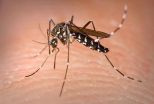(Press-News.org) WASHINGTON (Oct. 27, 2014) — Recent breakthroughs may pave the way for vaccines and new drugs for those infected by parasitic helminths. These flatworms, including tapeworms that cause hydatid diseases and neurocysticercosis, liver flukes, and blood flukes (schistosomes), infect more than 300 million people and cause approximately four million disability-adjusted life years lost due to chronic illness and death each year.
Paul Brindley, Ph.D., professor of microbiology, immunology, and tropical medicine, and scientific director of the Research Center for Neglected Diseases of Poverty at the George Washington University School of Medicine and Health Sciences, co-authored a perspective in the journal Science, calling for researchers to adapt new technologies to research these neglected pathogens.
"It took several years of work to sequence the genomes of the major species of flatworm parasites. However, now that we have this information, we can focus on genes of interest," said Brindley. "Even now, researchers are deploying retroviruses for transgenesis and genome editing of flatworm parasites to identify new ways to cure people who are afflicted by these infections. This is a major focus of research at the GW Research Center for Neglected Diseases of Poverty, which demonstrates the potential of what can already be done with new technologies."
In addition to breakthroughs in manipulation of genomes of these flatworm pathogens, as well as revolutionary strategies such as harnessing the bacterial clustered regulatory interspaced short palindromic repeats, known as CRISPR, isolation of organs of the parasites, characterization of stem cells of these worms, and advances in primary cell culture are expanding the molecular toolkit available to scientists. These resources are now all available to the scientific community. These technologies have been in use in mammals and model species for some time, but comparable research on neglected tropical disease helminth parasites has lagged far behind.
Brindley, along with his co-authors Karl Hoffman, Ph.D., professor of parasitology and leader of the Animal and Microbial Sciences Research Theme at Aberystwyth University, and Mathew Berriman, Ph.D., program leader for parasite genomics at the Wellcome Trust Sanger Institute, encourage researchers to take advantage of these breakthrough techniques to address long-asked questions about the pathogenesis, developmental biology, and evolution of flatworm parasites.
"Because of issues like global warming and migrations of people, these diseases are spreading," said Brindley. "While historically considered as tropical diseases, infections by these parasites have recently expanded to Western Europe, including Corsica, and expansions to other continents are expected. Current drugs, in use for the last 40 years, are unsustainable and in danger of over-reliance, unless new interventions are found."
INFORMATION:The full perspective, "Halting Harmful Helminths: Vaccines and New Drugs Are Needed to Combat Parasitic Worm Infections," is available at http://www.sciencemag.org/content/346/6206/168.summary.
Media: To interview Dr. Brindley, please contact Lisa Anderson at lisama2@gwu.edu or 202-994-3121
About the GW School of Medicine and Health Sciences:
Founded in 1824, the GW School of Medicine and Health Sciences (SMHS) was the first medical school in the nation's capital and is the 11th oldest in the country. Working together in our nation's capital, with integrity and resolve, the GW SMHS is committed to improving the health and well-being of our local, national and global communities. smhs.gwu.edu
GW researcher adapting breakthrough technologies to combat parasitic worm infections
Paul Brindley, Ph.D., co-authors an essay in Science on creating a pathway for vaccines and new drugs
2014-10-27
ELSE PRESS RELEASES FROM THIS DATE:
Boosting biogasoline production in microbes
2014-10-27
In the on-going effort to develop advanced biofuels as a clean, green and sustainable source of liquid transportation fuels, researchers at the U.S. Department of Energy (DOE)'s Joint BioEnergy Institute (JBEI) have identified microbial genes that can improve both the tolerance and the production of biogasoline in engineered strains of Escherichia coli.
Aindrila Mukhopadhyay, a chemist who directs the host engineering program for JBEI's Fuels Synthesis Division, led a study in which transcriptomic data and a synthetic metabolic pathway were used to identify several genes ...
NASA sees a 'Zombie' tropical storm kick off Halloween week
2014-10-27
NASA's Terra satellite spotted a "zombie" tropical storm as Halloween week kicks off. Tropical Depression 9 made landfall in Mexico's Yucatan Peninsula late last week and lingered as a remnant low pressure area on Saturday and Sunday, Oct. 25 and 26. Satellite data revealed that those remnants had reformed quickly and jumped up to tropical storm status, where it became "zombie" storm named Tropical Storm Hanna off the coast of Nicaragua. NASA's Terra satellite spotted strong thunderstorms around the zombie storm's center as it passed overhead.
At 9:30 a.m. EDT on Oct. ...
Ultrasound guides tongue to pronounce 'r' sounds
2014-10-27
Using ultrasound technology to visualize the tongue's shape and movement can help children with difficulty pronouncing "r" sounds, according to a small study by NYU's Steinhardt School of Culture, Education, and Human Development and Montclair State University.
The ultrasound intervention was effective when individuals were allowed to make different shapes with their tongue in order to produce the "r" sound, rather than being instructed to make a specific shape. The findings appear online in the Journal of Speech, Language, and Hearing Research.
The "r" sound is one ...
Slowing the biological clock
2014-10-27
Difficulty in conceiving a child is a major challenge for one in seven heterosexual couples in America, especially for those over the age of 35. Now a new discovery by researchers at Tel Aviv University and Chaim Sheba Medical Center at Tel Hashomer could boost the chances of conception in women undergoing in vitro fertilization (IVF) treatments.
Their new research reveals a linkage between the genes of the innate immune system — immunity with which human beings are born, rather than immunity they acquire during their lives — and ovarian longevity. The study, ...
'Sticky' ends start synthetic collagen growth
2014-10-27
Rice University researchers have delivered a scientific one-two punch with a pair of papers that detail how synthetic collagen fibers self-assemble via their sticky ends.
Collagen is the most common protein in mammals, a major component of bone and the fibrous tissues that support cells and hold organs together. Discovering its secrets may lead to better synthetic collagen for tissue engineering and cosmetic and reconstructive medicine.
The Rice lab of Jeffrey Hartgerink has been studying synthetic collagen for a decade, teasing out the details of how it starts as three ...
Hot on the trail of the Asian tiger mosquito
2014-10-27
The Asian tiger mosquito (Aedes albopictus), which is native to Southeast Asia, was spotted in Houston in 1985. By 1986 it had reached St. Louis and Jacksonville, Fla. Today it can be found in all of the southern states and as far north as Maine.
An aggressive daytime biter, Ae. albopictus has an affinity for humans and is also a vector for human disease, said Kim Medley, PhD, interim director of the Tyson Research Center at Washington University in St. Louis.
The mosquito arrived in the U.S. in a shipment of used tires from Japan. Ae. albopictus lays eggs that can ...
University of Delaware study connects penguin chick weights to local weather conditions
2014-10-27
Adélie penguins are an indigenous species of the West Antarctic Peninsula (WAP), one of the most rapidly warming areas on Earth. Since 1950, the average annual temperature in the Antarctic Peninsula has increased 2 degrees Celsius on average, and 6 degrees Celsius during winter.
As the WAP climate warms, it is changing from a dry, polar system to a warmer, sub-polar system with more rain.
University of Delaware oceanographers recently reported a connection between local weather conditions and the weight of Adélie penguin chicks in an article in Marine Ecology ...
Cost of informal caregiving for US elderly is $522 billion annually, study finds
2014-10-27
The price tag for informal caregiving of elderly people by friends and relatives in the United States comes to $522 billion a year, according to a new RAND Corporation study.
Replacing that care with unskilled paid care at minimum wage would cost $221 billion, while replacing it with skilled nursing care would cost $642 billion annually.
The study, published online by the journal Health Services Research, improves on earlier estimates about the value of informal caregiving by making use of the 2011 and 2012 American Time Use Survey, a new and unique database, to provide ...
PET scans reveal how psychodynamic therapy for depression may change brain function
2014-10-27
A study from Massachusetts General Hospital (MGH) investigators has identified for the first time changes in the metabolic activity of a key brain region in patients successfully treated for depression with psychodynamic psychotherapy, suggesting a mechanism of action behind one of the most historically important and widely practiced forms of therapy. They also found evidence that pretreatment metabolism in a different brain structure might predict which patients are likely to respond to that form of therapy. Their report will appear in the journal Psychotherapy and Psychosomatics ...
Blood vessel growth in the brain relies on a protein found in tumor blood vessels
2014-10-27
Do blood vessels that feed tumors differ from other blood vessels? Fourteen years ago, experiments designed to answer that question led to the discovery of several genes that are more active in tumor-associated blood vessels than in normal blood vessels. New research now reveals the normal function of one of those genes and suggests it could be a good target for anticancer drug therapy.
A summary of the research appears in the journal Developmental Cell on Oct. 27.
The mystery of the gene, TEM5, began in 2000 with research conducted by Brad St. Croix, Ph.D., working ...
LAST 30 PRESS RELEASES:
Making lighter work of calculating fluid and heat flow
Normalizing blood sugar can halve heart attack risk
Lowering blood sugar cuts heart attack risk in people with prediabetes
Study links genetic variants to risk of blinding eye disease in premature infants
Non-opioid ‘pain sponge’ therapy halts cartilage degeneration and relieves chronic pain
AI can pick up cultural values by mimicking how kids learn
China’s ecological redlines offer fast track to 30 x 30 global conservation goal
Invisible indoor threats: emerging household contaminants and their growing risks to human health
Adding antibody treatment to chemo boosts outcomes for children with rare cancer
Germline pathogenic variants among women without a history of breast cancer
Tanning beds triple melanoma risk, potentially causing broad DNA damage
Unique bond identified as key to viral infection speed
Indoor tanning makes youthful skin much older on a genetic level
Mouse model sheds new light on the causes and potential solutions to human GI problems linked to muscular dystrophy
The Journal of Nuclear Medicine ahead-of-print tip sheet: December 12, 2025
Smarter tools for peering into the microscopic world
Applications open for funding to conduct research in the Kinsey Institute archives
Global measure underestimates the severity of food insecurity
Child survivors of critical illness are missing out on timely follow up care
Risk-based vs annual breast cancer screening / the WISDOM randomized clinical trial
University of Toronto launches Electric Vehicle Innovation Ontario to accelerate advanced EV technologies and build Canada’s innovation advantage
Early relapse predicts poor outcomes in aggressive blood cancer
American College of Lifestyle Medicine applauds two CMS models aligned with lifestyle medicine practice and reimbursement
Clinical trial finds cannabis use not a barrier to quitting nicotine vaping
Supplemental nutrition assistance program policies and food insecurity
Switching immune cells to “night mode” could limit damage after a heart attack, study suggests
URI-based Global RIghts Project report spotlights continued troubling trends in worldwide inhumane treatment
Neutrophils are less aggressive at night, explaining why nighttime heart attacks cause less damage than daytime events
Menopausal hormone therapy may not pose breast cancer risk for women with BRCA mutations
Mobile health tool may improve quality of life for adolescent and young adult breast cancer survivors
[Press-News.org] GW researcher adapting breakthrough technologies to combat parasitic worm infectionsPaul Brindley, Ph.D., co-authors an essay in Science on creating a pathway for vaccines and new drugs




